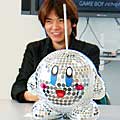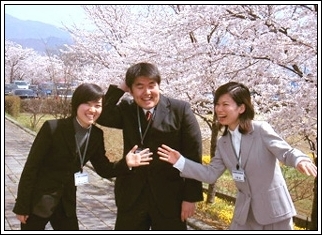| Conceiving Sickeningly Cute Puffballs | |
| HAL Laboratory: Company Profile | Page 5 |
 It's 1991 and 19-year-old Masahiro Sakurai has the project of making a new Game Boy game, one for beginning gamers in which any player can reach the ending with mild effort. During the production, Sakurai needed a dummy character until graphics and later code, would fill it. The character he created was a cute smiling bubble. As development progressed, everyone grew to like the little blob so much that they decided to keep him in the game.
It's 1991 and 19-year-old Masahiro Sakurai has the project of making a new Game Boy game, one for beginning gamers in which any player can reach the ending with mild effort. During the production, Sakurai needed a dummy character until graphics and later code, would fill it. The character he created was a cute smiling bubble. As development progressed, everyone grew to like the little blob so much that they decided to keep him in the game.
Apparently, Nintendo producer Shigeru Miyamoto wanted the character to be yellow but Sakurai insisted for him to be pink. The blob was first referred to as Popopo and then later renamed Kirby. Sakurai doesn't recall how Kirby ended up being named Kirby. While Kirby coincidentally has the same name as the Kirby vacuum brand (which has a similar sucking ability), it is unknown if this brand was the original inspiration. Another rumor is that in the 80's, Nintendo was faced with a gigantic lawsuit by the entertainment company MCA Universal, who claimed Nintendo was infringing upon its copyright of King Kong with the Donkey Kong Nintendo video game. Nintendo was still trying to get a foothold in the American market and this lawsuit threatened to destroy the company. The lawyer who was representing Nintendo was named John Kirby. It's rumored that a copy of the game was eventually sent to John Kirby who was humored and flattered.
For Sakurai, there was reportedly some tension leading to the creation of a Kirby title for the Nintendo 64. As the original Kirby's AirRide was being developed, the release date kept being pushed further into the future until the fateful day when the game was cancelled. Its been said the cancellation was due to an inability by the developers at getting the four-player mode to work at a decent frame rate using the Nintendo 64's limited technology. If there was more to it than that, we'll probably never know.
Shortly afterwards, it was revealed that the team would instead begin development on a new Kirby platform game (Kirby 64: The Crystal Shards) for the Nintendo 64 and that Sakurai would have no input. Supposedly, Sakurai didn't lay eyes on the game until it was released, where he played the game for the first time. Reports described Sakurai as 'sentimental', perhaps displaying the fact that he had lost interest in the series. Even then it had become clear that Sakurai was tiring of what he would later refer to as the "sequelization" of the industry.
"It was tough for me to see that every time I made a new game, people automatically assumed that a sequel was coming," said Masahiro Sakurai on August 26, 2003, in an interview with Nintendo Dream, two weeks after his resignation from HAL Laboratory. "Even if it's a sequel, lots of people have to give their all to make a game, but some people think the sequel process happens naturally."
On August 17, 2003, HAL Labs began undergoing major internal changes and restructuring efforts. HAL Labs announced it had extracted its entire main Nintendo-collaborative development studio out from its Nintendo Tokyo Prefecture Building location. HAL's other team in the Yamanashi development center was not affected or involved with the move.
HAL's Tokyo Development Center, which was located within the eighth floor of the Nintendo Tokyo Prefecture Building, was relocated to HAL's main office building in Kanda Suda-cho, Chiyoda-ku, Tokyo. The Kanda building is also supposedly the location of Nintendo's new Tokyo EAD studio and is where the Nintendo service center resided prior. Instead of three offices, HAL now has two - its combined Tokyo offices and its Yamanashi studio.
 The Nihombashi, Chuo-ku, Tokyo building - previously known as the Nintendo Tokyo Prefecture Building - now houses the complete Pokemon family. The NTPB building, or of which it is officially called Kawasaki Teitoku Bldg. Bekkan, has been given the moniker of The Pokemon Building. It houses The Pokemon Company, Creatures (creator of Pokemon cards, characters and scenarios) and Genius Sonority (Nintendo's new developer, who created Pokemon Colloseum) on the second floor, while the Pokemon Center Tokyo resides on the first floor. Several years ago Nintendo made the decision to organize everything Pokemon related under one roof. This is said to be a part of both Nintendo's and HAL's restructuring plans.
The Nihombashi, Chuo-ku, Tokyo building - previously known as the Nintendo Tokyo Prefecture Building - now houses the complete Pokemon family. The NTPB building, or of which it is officially called Kawasaki Teitoku Bldg. Bekkan, has been given the moniker of The Pokemon Building. It houses The Pokemon Company, Creatures (creator of Pokemon cards, characters and scenarios) and Genius Sonority (Nintendo's new developer, who created Pokemon Colloseum) on the second floor, while the Pokemon Center Tokyo resides on the first floor. Several years ago Nintendo made the decision to organize everything Pokemon related under one roof. This is said to be a part of both Nintendo's and HAL's restructuring plans.
Its speculated that all this may be related to the departure of Kirby and Super Smash Bros. producer Masahiro Sakurai just the week prior. Sakurai resigned from his position at HAL Laboratory on August 5, 2003. It's rumored that Sakurai wasn't happy with the reconstruction changes being made and decided to leave. Then again, the restructuring could instead be the result of such an influential and valuable person leaving. It is more likely however, that Sakurai was aware of the changes being set into motion and used that knowledge in making his decision to leave. This of course, combined with 'ideology' conflicts dating all the way back to the development of Kirby AirRide.
It was rumored that Sakurai found his creative liberties hindered within Nintendo's family and its development structure. "I left at my own free will, and not on the behalf of others," he said. Sakurai explained that he creates games first and foremost for gamers, and not developers or other companies. He explained, "I have more sense of freedom working with other creators."
Sakurai assured gamers that Kirby will continue to thrive under HAL and Nintendo's roof, but expressed concern over the future of his beloved Super Smash Bros. franchise. It has since become clear that one of the main reasons Sakurai left HAL was because he had tired of creating sequels.
"Every company has an achievement goal set," he said. "For the company to make profits, they have to make the right games. I have no intention of becoming a member or developer at a new company."
President Satoru Iwata and Masahiro Sakurai have since held a number of reconciliation meetings. As a result of the talks between the two Japanese gaming tycoons, Sakurai is now willing to work with Nintendo at some point in the future, although he will not be returning to his job at HAL Labs. Sakurai confirmed this report in an interview with the Japanese publication Nintendo Dream and also stated that Iwata was compassionate and understanding about the decision to leave HAL.
One can only hope someday that HAL will be able to replace Sakurai's magic.
Conceiving New Talent
HAL hires new employees on a yearly basis. Each March, while Mt. Fuji rests in the distance and the cherry trees are glowing in full pink and red blossom in front of the Yamanashi development center, new recruits begin their introduction and training for the work of HAL Laboratory. Their nervous excitement fills the air.

The new employees are introduced to the entire HAL staff during an introduction meeting and ceremony. All new employees are trained in thoroughly with 17 lectures, everything from the corporate culture to the simple task of answering and using the telephone. After this technical training is completed, more specific occupational training is performed. Altogether, training lasts for about three to four months. Further lessons are held on a volunteer basis - including lessons on the English language, mathematics, design and art.
With Nintendo at its side, HAL Laboratory is prepared to grab hold of the reigns of the future. Just as it was with the Nintendo 64 and Nintendo GameCube, HAL will be at the forefront of Revolution hardware and software development.
There's no denying the company has had a tumultuous history. It's a lot easier to appreciate how far you've come when you actually had to work to get there. From being on the verge of bankruptcy to tackling the difficulties of three-dimensional development, HAL has managed to persevere. This perseverance is what moves this industry forward. HAL's innovation, spirit and warmth is something we will surely see in the years ahead.
If nothing else, we've already had a glimpse of it through the direction former HAL president Satoru Iwata is steering Nintendo -- the idea that interactive entertainment should be played and enjoyed by everyone.
Thank you to Nintendo Co., Ltd., HAL Laboratory, James Burns, Starmen.net, futuredisk.msxnet.org, generation-msx.nl, Ninja Kirby from Absolute Anime, and ClassicGaming.com/Kirby.